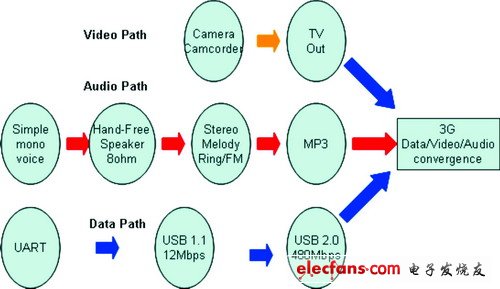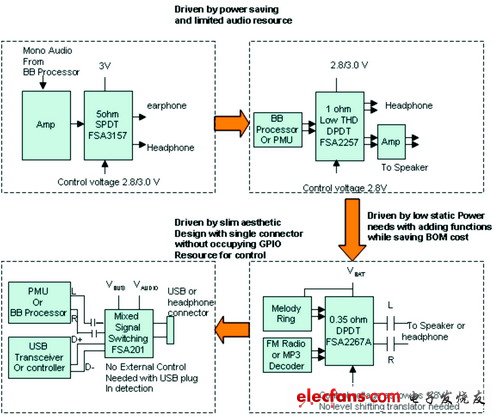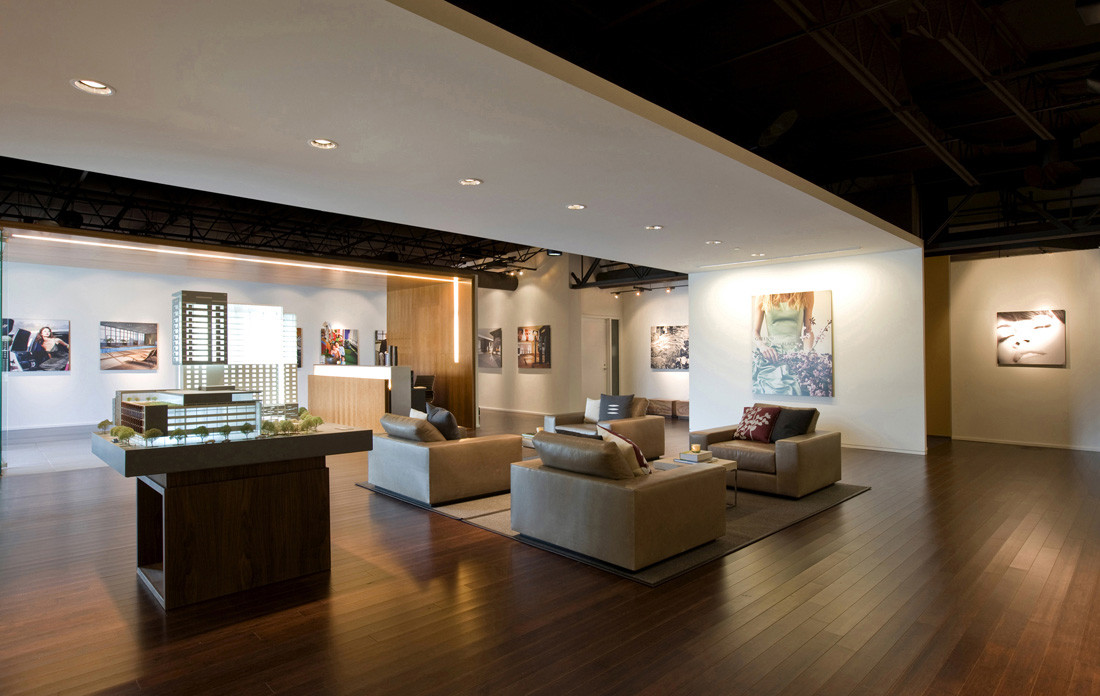introduction
Compared with traditional high-power MOSFET switches in power supply design applications and multi-bit data bus switches in storage applications, analog switches are very different. In general, analog switches are mainly used to switch low-power analog signals in portable designs such as mobile phones. However, driven by additional functions in recent portable designs, analog switches have evolved from traditional low-bandwidth audio switches to high-speed mixed-signal switches. Due to its low power consumption, low leakage current, and small package, analog switches can even be used as low-power DC signal switches in some designs. This article will introduce the migration trajectory of analog switches to allow readers to understand the market trend of portable baseband design.
Transition trajectory

Figure 1 Baseband functions promote the changes of mobile phone functions
As shown in Figure 1, the mobile phone has evolved from a simple single voice function to a communication tool with high-power stereo audio such as MP3 or music ringtones. As for video functions, simple low-resolution cameras are outdated, and cameras with more than 2 million pixels have become standard features in most mid- to high-end mobile phones. Since the low-power digital broadcast tuner is suitable for portable applications, mobile phones with composite video output will emerge strongly in the market, thus meeting the needs of professional applications such as external large displays or professional projector displays.
Modern mobile phone designs are embedded with MP3 functions. For the data path, the traditional UART-based interface can no longer meet the download requirements of end users. Therefore, USB 1.1
Full speed (12Mbp) or even USB 2.0 high-speed interface is becoming more and more common in the design of MP3 mobile phones with embedded hard disk or removable large storage.
Audio-only switches migrate from high on-resistance to ultra-low on-resistance
In response to the changes in mobile phone functions in Figure 1, the initial use of analog switches in mobile phone design is because most baseband processors have only limited audio output ports, as shown in Figure 2. Those low-end processors only have a single voice output, which usually requires voice isolation to be connected to the earpiece or headset respectively. Relative to the headphone impedance of 32 ohms, these switches usually have a relatively high on-resistance of about 10 ohms. The insertion loss of the switch is compensated by the preamplifier stage. The control voltage in most applications is consistent with the 3V power supply of the switch.

Figure 2 Changes in analog switch application functions in portable design
Driven by the demand for energy saving and better total harmonic distortion (THD), a 1 ohm switch has appeared on the market with a flat on-resistance between the input voltage of 0 and VCC. For functions such as speakerphones, the voice output from the baseband processor can be routed to the headset and the internal 8-ohm speaker. Because the amplifier is placed after the switch and before the speaker (see Figure 2), the THD specification becomes a key factor in these applications to reduce signal amplification distortion.
As most baseband processor designs need to further reduce power consumption, general purpose I / O (GPIO) digital interfaces need to provide lower output high voltage threshold levels (VOH). For this application, the voltage can be as low as 1.8V. However, due to the demand for high-power stereo audio in MP3 phones, the switching power supply voltage can reach 4.2V, or be directly powered by batteries. Because there is a mismatch between the control voltage input high level (VIH) and the switching power supply voltage, the design requires an additional level shift converter to reduce the static leakage current. This not only increases the design difficulty, but also increases the material cost. In such portable applications, analog switches capable of identifying low control voltages (1.8V) are highly needed.
Because of the positive power supply, the analog switch is recommended for transmitting positive level signals, so it is necessary to set the AC coupling capacitor after the switch to block the DC component of the earphone or receiver. At the same time, considering that the impedance of the speaker is about 8 ohms, audio switches in such applications under 4.3V power supply generally have an on-resistance as low as 0.35 ohm, which can further reduce the insertion loss caused by the high on-resistance switch Power consumption.
Here you can find the related products in Grille Down Light , we are professional manufacturer of Grille Down Lights,Ceiling Downlights,Led Recessed Ceiling Downlights,Cri90 Ceiling Downlights. We focused on international export product development, production and sales. We have improved quality control processes of Grille Down Light to ensure each export qualified product.
Whatever you are a group or individual, we will do our best to provide you with accurate and comprehensive message about Grille Down Light!

Grille Down Light
Grille Down Lights,Ceiling Downlights,Led Recessed Ceiling Downlights,Cri90 Ceiling Downlights
Guangdong Decosun Lighting Technology Co.,Ltd , https://www.decosun-lighting.com